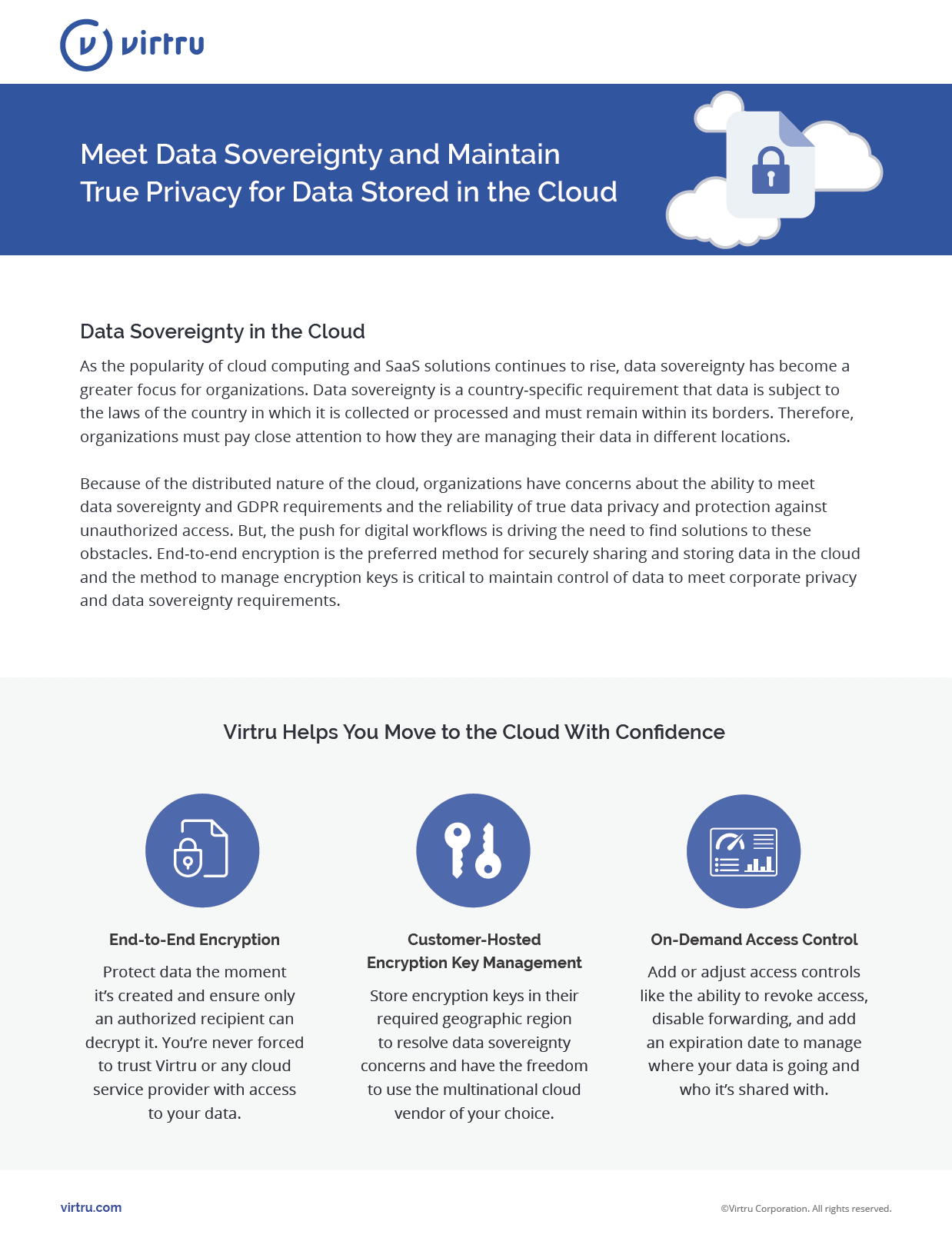5 Myths About Cloud Migrations, Debunked


For all the reasons companies decide to move to the cloud (and there are many), there are almost as many reasons why companies hesitate to take this important step. While some hesitations are valid, there are a lot of myths about moving to the cloud. In this post, we’ll explore five common misconceptions about undergoing a cloud migration, and why you shouldn’t let those myths hold you back.
Myth #1: I have more control over my data when I manage it on premise.
This is not always true—and, in fact, many legacy, on-premise systems can leave you more vulnerable to cyber attacks. While there are certain use cases for managing some data on premise—or, better yet, using a private cloud (e.g., managing encryption key policies or unencrypted data as part of specific workflows), you can generally protect data in the cloud more effectively than you can on premise.
The Microsoft Exchange Server attack in 2021 demonstrated that hosting email, files, and data lakes on premise can actually be a liability. Attacks exploiting vulnerabilities in Microsoft Exchange Server software began in January 2021, but patches weren’t deployed until early March. This means many affected organizations had to wait for Microsoft to spend 4-6 weeks developing patches.
However, companies that store data in the cloud, with additional layers of security like Virtru’s data encryption solutions, can take action immediately in the face of a cyber attack or threat. By managing encryption keys and their associated policies using a distributed architecture, you can rotate encryption keys and mitigate damage right away. With Virtru, you can also revoke all access to shared files, the equivalent of having a “big red button” to lock down data in case of an emergency.
The future is cloud-based. On-premise solutions are no longer a priority for software giants; on-premise software has taken a backseat in terms of new releases, updates and patches. A fully on-premise tech stack for managing the entirety of a company’s data just isn’t sustainable—at the very least, it can hold organizations back from becoming more nimble and innovative.
Myth #2: Government and other highly regulated industries can’t use the cloud. It’s not secure enough.
Highly regulated organizations, and even governments, are moving to the cloud at a rapid pace. This is true even for those subject to tough compliance regulations like ITAR, CMMC, HIPAA, or GDPR.
Cloud solutions alone, “off the shelf,” are likely not secure enough for highly regulated industries and governments. However, with Virtru’s encryption as an added layer of protection, you can unlock all the benefits of the cloud while still safeguarding your data.
Virtru is a leading encryption provider for Google Workspace, Gmail, and Google Drive. Brown University uses Virtru and Google Workspace to empower students and faculty to share data securely. The state of Maryland uses Virtru to maintain Criminal Justice Information Services (CJIS) compliance in the cloud, and the Massachusetts Municipal Association uses Virtru for HIPAA-compliant email protection.
Whether using cloud-based email and collaboration tools, storing a data lake in the cloud, or leveraging cloud-based SaaS apps like Salesforce, Zendesk, SAP, or Workday, Virtru’s encryption solutions can be layered in for greater security, so many of the strictest compliance regulations can still be met.
Myth #3: My company is based outside the U.S. and we can’t maintain data sovereignty while using a U.S.-based cloud provider like Google or Amazon.
Data sovereignty refers to the idea that data is subject to the laws and regulations of the geographic location where that data is collected and processed. Many companies outside the U.S. are hesitant to move to cloud platforms like Amazon, Google, and Microsoft, out of concern that they will not be able to maintain true ownership over their data.
However, these U.S. cloud providers now account for 66% of the European market. The good news is that companies don’t have to sacrifice true ownership of their data for the benefits of the cloud: They can maintain data sovereignty and control of their data, everywhere it’s stored by protecting it with the client-side encryption that Virtru provides. Virtru’s end-to-end encryption solutions satisfy data sovereignty requirements by protecting sensitive data at the time of creation and providing the ability to store encryption keys in their required geographic region while allowing the organization to continue using the multinational cloud vendor of their choice.
Myth #4: Moving to the cloud is cost prohibitive.
While there is an upfront cost to move to the cloud, it can actually alleviate costs over time once successfully implemented — and if your organization takes this opportunity to rethink your approach to managing data. A lift-and-shift move to the cloud might cost you more, but taking the time to reduce redundancies and optimize your data frameworks can actually be more affordable than an on-premise data center. Not to mention, the agility of the cloud is table stakes for innovation: Making the move to the cloud can be more sustainable for the growth of your business.
By moving to the cloud, companies can eliminate redundancies, streamline their technology stack, and increase flexibility and speed to market. It’s true that business technology strategy is often the driver of overall strategy and growth for an organization. In a 2020 survey conducted by Deloitte and WSJ Intelligence, 40% of surveyed CEOs said that CIOs (or similar tech leaders) would be the key driver of business strategy in the next three to five years.
Many large organizations are saddled with significant technical debt, which can also delay a cloud migration. If this is the case, ensure your organization is looking at a long-term strategy for lessening the burdens of legacy technology, and setting aside the necessary funds to reduce spend for those solutions that are no longer serving your business.
Myth #5: My staff can’t support a cloud environment.
In a Virtru case study, Ken Cheney, the acting CIO of Maryland’s Department of Education, shared his advice for cloud migrations: “I suggest using in-house employees to train your team. Invest in making experts out of a select group of people in your organization and get them to share their knowledge. Not only do people respond better to training from peers and colleagues, but this way your trainers will have an intimate knowledge of the organization which really helps when rolling out the new systems.”
The truth is that no one knows your data better than your own teams. Give them the chance to help drive your cloud migration strategy, and give them input in the vendors and partners you select. By ensuring alignment with internal teams, you may discover important nuances or requirements that will impact your overall cloud strategy.
In tandem with your cloud migration, prioritize training for your teams. This will give your employees a chance to grow and modernize their skills. It can also create leadership opportunities for rising tech stars within your organization.
Moving to the cloud can unleash greater productivity, data sharing, and innovation for your organization—and for many companies, file and email encryption (with self-hosted keys) can be a game changer. To learn how Virtru can enable your cloud migration, contact us today.
Meet Data Sovereignty and Maintain True Privacy for Cloud Data
See why Virtru’s end-to-end encryption solutions satisfy data sovereignty requirements by protecting sensitive data at the time of creation and providing the ability to store encryption keys in their required geographic region while allowing the organization to continue using the multinational cloud vendor of their choice.
Get the Data Sheet

Megan Leader
Megan is the Director of Brand and Content at Virtru. With a background in journalism and editorial content, she loves telling good stories and making complex subjects approachable. Over the past 15 years, her career has followed her curiosity — from the travel industry, to payments technology, to cybersecurity.
View more posts by Megan Leader









